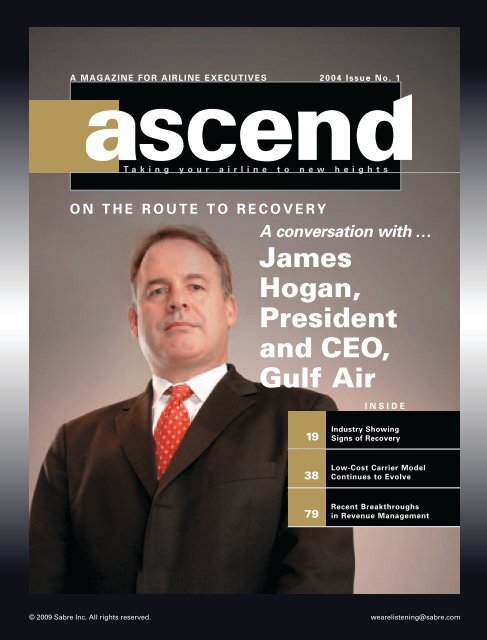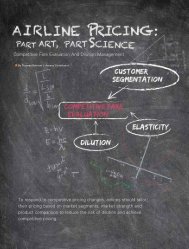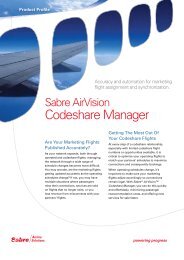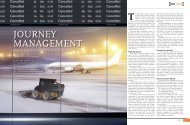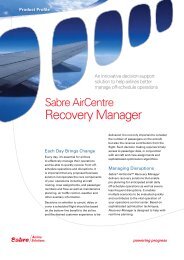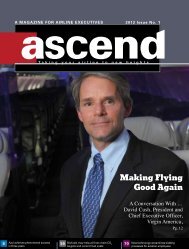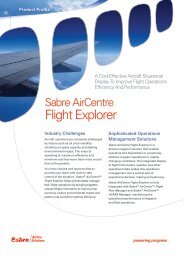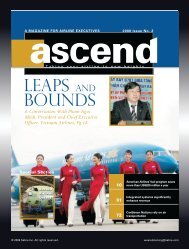Geoff Dixon, CEO, Qantas Airways James Hogan, President and ...
Geoff Dixon, CEO, Qantas Airways James Hogan, President and ...
Geoff Dixon, CEO, Qantas Airways James Hogan, President and ...
Create successful ePaper yourself
Turn your PDF publications into a flip-book with our unique Google optimized e-Paper software.
A MAGAZINE FOR AIRLINE EXECUTIVES<br />
2004 Issue No. 21<br />
T a k i n g y o u r a i r l i n e t o n e w h e i g h t s<br />
AO N AT HL LE I ER D O UF RT OE NT TO<br />
R E C O V E R Y<br />
A conversation with A conversation … with …<br />
<strong>Geoff</strong> <strong>Dixon</strong>, <strong>James</strong> <strong>CEO</strong>,<br />
<strong>Qantas</strong> <strong>Airways</strong> <strong>Hogan</strong>,<br />
<strong>President</strong><br />
<strong>and</strong> <strong>CEO</strong>,<br />
Gulf Air<br />
Low-Cost<br />
Air France<br />
Carrier<br />
<strong>and</strong> KLM<br />
Model<br />
form<br />
Continues<br />
Europe’s Largest<br />
to Evolve<br />
Airline<br />
Recent Breakthroughs<br />
The<br />
in Revenue<br />
Evolution<br />
Management<br />
of Alliances<br />
A Conversation with<br />
oneworld, SkyTeam<br />
<strong>and</strong> Star Alliance<br />
© 2009 Sabre Inc. All rights reserved. wearelistening@sabre.com<br />
19<br />
38 4<br />
18 79<br />
26<br />
I N S I D E<br />
Industry Showing<br />
Signs of<br />
I<br />
Recovery<br />
N S I D E
6<br />
Photo courtesy of Iberia Airlines<br />
6 ascend<br />
profile<br />
Iberia<br />
Airlines<br />
FOCUSED STRATEGY FOR<br />
AN OPTIMISTIC FUTURE<br />
By staying the course of its strategic plans, Iberia Airlines is poised<br />
to continue its recovery <strong>and</strong> preserve its position as one of Europe’s<br />
leading carriers.<br />
By Gary Thompson<br />
Ascend Contributor<br />
Iberia Airlines, the Spanish national<br />
carrier, has seen its profits take off<br />
during the past three years, achieving<br />
operating profits from 2001 through<br />
2003. Last year, the airline, which is<br />
currently in its third three-year strategic<br />
“Director Plan,” earned €4.6 billion<br />
(US$5.7 billion) in operating revenues,<br />
a sign of the carrier’s strength despite<br />
the industry’s economic condition.<br />
Without a doubt, 2003 was a year of great<br />
change in the airline industry. But for<br />
Iberia Líneas Aéreas de España, the<br />
national airline of Spain, the year’s<br />
changes marked a continuation of its recovery<br />
<strong>and</strong> transformation into a commercially successful<br />
global airline.<br />
The airline’s ability to weather the storm<br />
has been proven through its financial results of<br />
the past few years. For 2003, Iberia earned a<br />
€161 million (US$199 million) operating profit,<br />
<strong>and</strong> in 2002, Iberia posted an operating profit<br />
of €249 million (US$314 million) <strong>and</strong> a net profit<br />
of €157 million (US$198 million). Even in<br />
2001, when the industry suffered its worst<br />
financial year in history, Iberia turned a €5 million<br />
(US$6 million) operating profit <strong>and</strong> a €50<br />
million (US$63 million) net profit.<br />
For Iberia, however, recovery was not<br />
an overnight process. Rather, the foundation<br />
for the profitability the airline has enjoyed<br />
recently was poured a decade ago. The key to<br />
Iberia’s ongoing success has been its management’s<br />
focused strategy <strong>and</strong> discipline to<br />
implement it, <strong>and</strong> its desire to ensure it maintains<br />
a competitive edge <strong>and</strong> exceeds its customers’<br />
expectations.<br />
“Iberia decided to adopt a strict policy<br />
of cost control long before 2001, the fruits of<br />
which were demonstrated during the worst<br />
crisis the industry has suffered to date,” said<br />
Angel Mullor, consejero delegado for Iberia.<br />
“At the same time, operational <strong>and</strong> financial<br />
flexibility was a key focus for Iberia. The crisis<br />
that has affected the industry over the past<br />
two years has underlined the fact that airlines<br />
today need to be extremely focused on controlling<br />
their costs <strong>and</strong> planning, while at the<br />
same time, they need to be more flexible.”<br />
Ten years ago, with the liberalization of<br />
the Spanish market, Iberia’s leadership realized<br />
it would have to adapt to a new airline<br />
industry. In 1994, the airline launched a threeyear<br />
“Viability Plan,” which featured initiatives<br />
to cut costs <strong>and</strong> reduce holdings in other airlines.<br />
Following the Viability Plan, the airline<br />
launched its first “Director Plan” in 1997 in<br />
conjunction with the full phase-in of the liberalization<br />
of the air transport industry in the<br />
European Union.
“ The key to Iberia’s ongoing success has<br />
been its management’s focused strategy<br />
<strong>and</strong> discipline to implement it, <strong>and</strong><br />
its desire to ensure it maintains a<br />
competitive edge <strong>and</strong> exceeds its<br />
customers’ expectations. ”<br />
Photo courtesy of Iberia Airlines
8<br />
The first Director Plan was highlighted<br />
by finalizing agreements with British <strong>Airways</strong><br />
<strong>and</strong> American Airlines, which led to the founding<br />
of the oneworld alliance. It also embarked<br />
on a fleet renewal program — moving to the<br />
A320 for short- <strong>and</strong> medium-range flights <strong>and</strong><br />
the A340 for long-haul flights — <strong>and</strong> rationalized<br />
its route network. As a result of the first<br />
Director Plan, revenues exceeded the plan by<br />
6.2 percent, <strong>and</strong> income before taxes was 62<br />
percent above plan.<br />
“ … Iberia continues to maintain a<br />
leadership position on Europe/Latin<br />
America routes in terms of number<br />
of destinations, number of non-stop<br />
flights <strong>and</strong> daily frequencies. ”<br />
In 2000, a second Director Plan began,<br />
featuring the airline’s initial public offering, the<br />
sale of Binter Mediterraneo <strong>and</strong> Binter<br />
Canarias, <strong>and</strong> the launch of iberia.com <strong>and</strong><br />
electronic ticketing. The second Director Plan<br />
brought about the strong growth of the airline’s<br />
European market <strong>and</strong> the development<br />
of enhanced customer service plans.<br />
Last year, the airline entered a third<br />
Director Plan, which aims to reduce costs by 8<br />
percent to 10 percent; increase the margin of<br />
earnings before interest, taxes, depreciation,<br />
amortization <strong>and</strong> rent above 19 percent;<br />
<strong>and</strong> achieve a return on equity of at least 15<br />
percent.<br />
These targets are within reach given<br />
Iberia's 2002 EBITDAR margin of 17.1 percent<br />
(compared with 13.8 percent in 2001) <strong>and</strong><br />
ROE of 12 percent. Through the third Director<br />
Plan, the airline seeks to achieve these objectives<br />
through further cost-cutting initiatives,<br />
preserving Iberia's leading position on<br />
Europe/Latin America routes, <strong>and</strong> making its<br />
domestic <strong>and</strong> European point-to-point routes<br />
profitable. Specific targets include a capacity<br />
increase of at least 22 percent over the plan’s<br />
three-year period, a rise in fleet utilization of 9<br />
percent <strong>and</strong> a 15 percent reduction in costs.<br />
As it continues its recovery, the airline is<br />
now back to focusing on growth. Orders for<br />
A320/A321 aircraft that were put on hold<br />
began arriving this year, <strong>and</strong> it will replace its<br />
fleet of Boeing 747s with eight A340-600s,<br />
which will be assigned on routes to North <strong>and</strong><br />
South America.<br />
Another key element of Iberia’s focused<br />
strategy for continued growth is to take full<br />
ascend<br />
profile<br />
Part of Iberia Airlines’ strategy for future growth includes taking advantage of<br />
planned expansions at Barcelona El Prat Airport <strong>and</strong> Madrid Barajas Airport, both<br />
of which will increase passenger capacity between 30 percent to 40 percent during<br />
the next three years, much greater than any other major European airport.<br />
Through its series of three-year strategic plans, Iberia Airlines has not taken a<br />
quixotic approach to future success. Rather than chasing at windmills like the<br />
famous Spanish literary character Don Quixote, the airline identified specific<br />
achievable goals <strong>and</strong> set out to realize them.<br />
Photo courtesy of Iberia Airlines<br />
Sabre Airline Solutions
advantage of the planned airport expansions at<br />
Barcelona El Prat — which will open an additional<br />
runway this year <strong>and</strong> a new terminal in<br />
2005 — <strong>and</strong> Madrid Barajas — which will add<br />
two new runways <strong>and</strong> a terminal this year.<br />
This will result in passenger capacity growth<br />
of between 30 percent <strong>and</strong> 40 percent at<br />
Barcelona <strong>and</strong> Madrid during the next three<br />
years — much greater than any other major<br />
European airport.<br />
“Iberia is already the natural ‘bridge’<br />
between Europe <strong>and</strong> Latin America, <strong>and</strong> the<br />
new expansion reinforces our position,” said<br />
Enrique Donaire, director general of the airline.<br />
“The aggressive growth of the airports in<br />
Madrid <strong>and</strong> Barcelona will allow us to dramatically<br />
increase our offerings to Latin America,<br />
while at the same time, offer better facilities<br />
for our European connections.”<br />
Altogether, Iberia will spend more than<br />
€1.5 billion (US$1.9 billion) on aircraft <strong>and</strong> terminal<br />
profile<br />
improvements. Management claims that if aircraft<br />
productivity targets are not achieved,<br />
capacity will be increased even further than<br />
planned through additional wet leasing.<br />
“ Iberia decided to adopt a strict<br />
policy of cost control long before<br />
2001, the fruits of which were<br />
demonstrated during the worst<br />
crisis the industry has suffered<br />
to date. At the same time, operational<br />
<strong>and</strong> financial flexibility<br />
was a key focus for Iberia. ”<br />
The third Director Plan remains on<br />
course, <strong>and</strong> Iberia continues to maintain a<br />
leadership position on Europe/Latin America<br />
T H E H I G<br />
vıew<br />
H L E V E L<br />
News Briefs from Around the Globe<br />
Who<br />
Aeropostal<br />
What<br />
Implemented the Sabre ® AirCrews ®<br />
Crew Management suite <strong>and</strong> the<br />
Sabre ® AirOps Control suite through<br />
the application service provider delivery<br />
method, the Sabre ® eMergo ®<br />
Web-enabled <strong>and</strong> dedicated network<br />
solutions. As a result of the implementation,<br />
Aeropostal has automated<br />
two key functional areas.<br />
Why<br />
“With the increased efficiencies in the<br />
operations <strong>and</strong> crewing processes,<br />
travelers should encounter less flight<br />
delays <strong>and</strong> cancellations, which then<br />
improves customer satisfaction,” said<br />
Licio Piccoli, chief information officer<br />
for Aeropostal.<br />
The systems will help Aeropostal<br />
integrate its crew <strong>and</strong> operations areas.<br />
“Implementation of the AirCrews<br />
suite has benefited Aeropostal by permitting<br />
a much greater level of control<br />
regarding the utilization of our<br />
manpower,” said Capt. Enrique Zerpa,<br />
responsible for the coordination <strong>and</strong><br />
implementation of the AirCrews suite.<br />
“By integrating functions between the<br />
AirCrews <strong>and</strong> AirOps suites <strong>and</strong> the<br />
schedule generated by the Sabre ®<br />
AirFlite Schedule Manager, we are<br />
able to operate more efficiently.<br />
The Sabre ® AirCrews ® Crew<br />
Connection has provided the crews<br />
with an efficient <strong>and</strong> low-cost means<br />
of communicating with the rostering<br />
department to h<strong>and</strong>le such items<br />
as flight, days off, swaps, requests<br />
for specific duties <strong>and</strong> many other<br />
routes in terms of number of destinations,<br />
number of non-stop flights <strong>and</strong> daily frequencies.<br />
To maintain its position <strong>and</strong> compete in<br />
such a tough commercial environment, Iberia<br />
officials recognize that they will need to continue<br />
their focus <strong>and</strong> determination to develop<br />
competitive service <strong>and</strong> prices in domestic<br />
<strong>and</strong> European point-to-point routes, maintain a<br />
competitive cost base on par with low-cost<br />
carriers, <strong>and</strong> maximize the value of the different<br />
airline-related businesses. The foundation<br />
has been laid, the strategy is in motion <strong>and</strong> the<br />
future is optimistic. a<br />
Gary Thompson is the Europe-based<br />
account director for Iberia Airlines.<br />
He can be contacted at<br />
gary.thompson@sabre.com.<br />
functions that normally took up a lot<br />
of the schedulers’ time in answering<br />
telephone calls.”<br />
The airline also benefited from<br />
the lower total cost of ownership<br />
by accessing the suites through<br />
an ASP.<br />
“We do not have the resources<br />
to dedicate to the installation of an<br />
onsite system operations control<br />
center, but with the eMergo solutions,<br />
we get the technology without the<br />
expensive upfront hardware costs<br />
or the ongoing cost to maintain<br />
the system,” Piccoli said. “In<br />
addition, Sabre Airline Solutions<br />
made accessing the system easy<br />
by linking Unix servers to personal<br />
computers for a graphical user<br />
interface such as the use of a<br />
three-button mouse.” a


